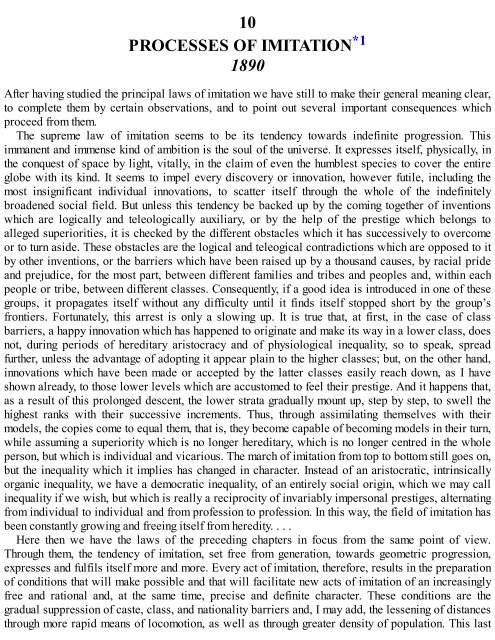3658925934
You also want an ePaper? Increase the reach of your titles
YUMPU automatically turns print PDFs into web optimized ePapers that Google loves.
10<br />
PROCESSES OF IMITATION *1<br />
1890<br />
After having studied the principal laws of imitation we have still to make their general meaning clear,<br />
to complete them by certain observations, and to point out several important consequences which<br />
proceed from them.<br />
The supreme law of imitation seems to be its tendency towards indefinite progression. This<br />
immanent and immense kind of ambition is the soul of the universe. It expresses itself, physically, in<br />
the conquest of space by light, vitally, in the claim of even the humblest species to cover the entire<br />
globe with its kind. It seems to impel every discovery or innovation, however futile, including the<br />
most insignificant individual innovations, to scatter itself through the whole of the indefinitely<br />
broadened social field. But unless this tendency be backed up by the coming together of inventions<br />
which are logically and teleologically auxiliary, or by the help of the prestige which belongs to<br />
alleged superiorities, it is checked by the different obstacles which it has successively to overcome<br />
or to turn aside. These obstacles are the logical and teleogical contradictions which are opposed to it<br />
by other inventions, or the barriers which have been raised up by a thousand causes, by racial pride<br />
and prejudice, for the most part, between different families and tribes and peoples and, within each<br />
people or tribe, between different classes. Consequently, if a good idea is introduced in one of these<br />
groups, it propagates itself without any difficulty until it finds itself stopped short by the group’s<br />
frontiers. Fortunately, this arrest is only a slowing up. It is true that, at first, in the case of class<br />
barriers, a happy innovation which has happened to originate and make its way in a lower class, does<br />
not, during periods of hereditary aristocracy and of physiological inequality, so to speak, spread<br />
further, unless the advantage of adopting it appear plain to the higher classes; but, on the other hand,<br />
innovations which have been made or accepted by the latter classes easily reach down, as I have<br />
shown already, to those lower levels which are accustomed to feel their prestige. And it happens that,<br />
as a result of this prolonged descent, the lower strata gradually mount up, step by step, to swell the<br />
highest ranks with their successive increments. Thus, through assimilating themselves with their<br />
models, the copies come to equal them, that is, they become capable of becoming models in their turn,<br />
while assuming a superiority which is no longer hereditary, which is no longer centred in the whole<br />
person, but which is individual and vicarious. The march of imitation from top to bottom still goes on,<br />
but the inequality which it implies has changed in character. Instead of an aristocratic, intrinsically<br />
organic inequality, we have a democratic inequality, of an entirely social origin, which we may call<br />
inequality if we wish, but which is really a reciprocity of invariably impersonal prestiges, alternating<br />
from individual to individual and from profession to profession. In this way, the field of imitation has<br />
been constantly growing and freeing itself from heredity. . . .<br />
Here then we have the laws of the preceding chapters in focus from the same point of view.<br />
Through them, the tendency of imitation, set free from generation, towards geometric progression,<br />
expresses and fulfils itself more and more. Every act of imitation, therefore, results in the preparation<br />
of conditions that will make possible and that will facilitate new acts of imitation of an increasingly<br />
free and rational and, at the same time, precise and definite character. These conditions are the<br />
gradual suppression of caste, class, and nationality barriers and, I may add, the lessening of distances<br />
through more rapid means of locomotion, as well as through greater density of population. This last









![Genki - An Integrated Course in Elementary Japanese II [Second Edition] (2011), WITH PDF BOOKMARKS!](https://img.yumpu.com/58322134/1/180x260/genki-an-integrated-course-in-elementary-japanese-ii-second-edition-2011-with-pdf-bookmarks.jpg?quality=85)
![Genki - An Integrated Course in Elementary Japanese I [Second Edition] (2011), WITH PDF BOOKMARKS!](https://img.yumpu.com/58322120/1/182x260/genki-an-integrated-course-in-elementary-japanese-i-second-edition-2011-with-pdf-bookmarks.jpg?quality=85)





